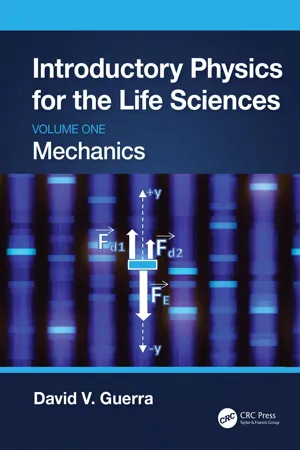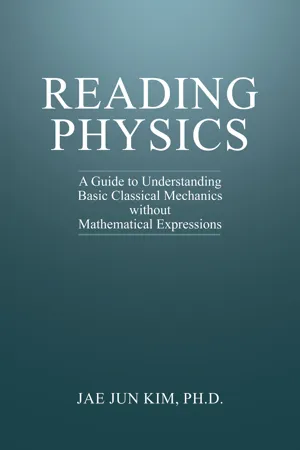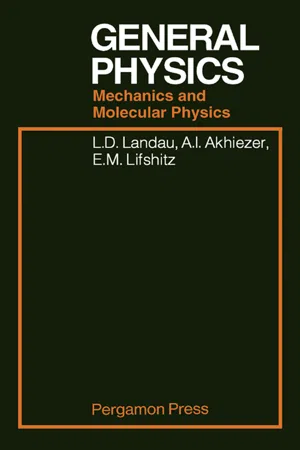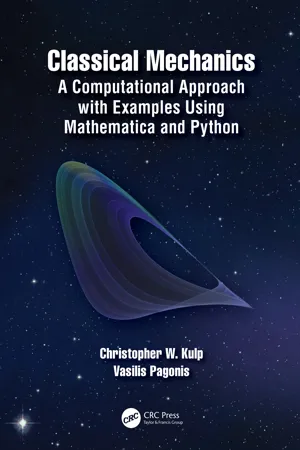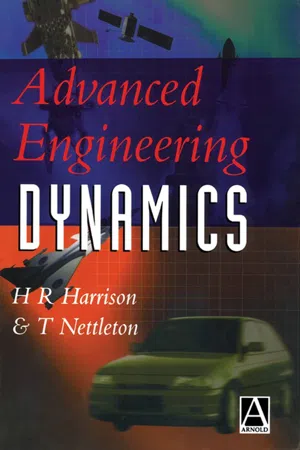Physics
Rotational Motion Equations
Rotational motion equations describe the motion of objects that rotate around an axis. They include equations for angular velocity, angular acceleration, and rotational kinetic energy. These equations are analogous to the linear motion equations and are used to analyze and predict the behavior of rotating objects.
Written by Perlego with AI-assistance
Related key terms
11 Key excerpts on "Rotational Motion Equations"
- David V. Guerra(Author)
- 2023(Publication Date)
- CRC Press(Publisher)
13 Rotational Motion
DOI: 10.1201/9781003308065-1313.1 Introduction
Rotational motion is the motion of an object spinning around an axis that passes through the object itself. This is to be contrasted with translational motion, which is the motion of an object moving through space in a straight or curved path without rotation. As demonstrated in Figure 13.1 , a block sliding down an incline moves with only linear motion defined by a displacement, a velocity, and an acceleration. A disk rotating about a fixed axis moves with only rotational motion, but a ball rolling down an incline experiences both rotational and linear motion.FIGURE 13.1 Examples of different types of motion.As demonstrated in Chapter 12 , when an object is traveling in a circular path, the concepts of translation kinematics are commonly applied to the analysis, but sometimes the concepts of rotational motion, period, frequency, and angular frequency can be applied. So, circular motion provides a transition between the language of translational and rotational motion, which is formalized in this chapter. In addition, rotational dynamics will formalize the connection between the net rotational force, or net torque, on an object and the angular acceleration of the object.- Chapter question: There are bacteria that employ a rotating flagellum, tails that look a bit like a corkscrew, to propel themselves forward. In normal situations, these propulsion systems work well to move these bacteria forward through water. On the other hand, when a drop of water containing these bacteria is placed on a microscope slide, the bacteria begin to move in approximately circular paths at fairly constant speeds (Figure 13.2 ).
FIGURE 13.2
- No longer available |Learn more
- Robert A. Pelcovits, Joshua Farkas(Authors)
- 2023(Publication Date)
- Barrons Educational Services(Publisher)
6Rotation I: Kinematics, Force, Work, and Energy
Learning Objectives
In this chapter, you will learn:Definitions of angular position, velocity, and accelerationRelationships between angular and translational kinematic quantitiesRotational kinetic energy; rotational inertiaTorqueRotational analog of Newton’s second lawWork and power in rotational motionThis chapter explores the rotation of rigid bodies about fixed axes. Newton’s laws are valid for rotational motion just as they apply to linear motion. However, it will help to recast kinematics and Newton’s second law into a more useful form for dealing with rotational motion.The Motivation for Developing New Parameters
When an object is undergoing pure translational motion, every particle in the object has the same displacement, velocity, and acceleration. When a rigid body is rotating about an axis, every particle in the object moves in a circular path about the axis, but the particles can have different velocities and accelerations (e.g., particles farther away from the axis move faster), making it impossible to assign a single velocity or acceleration to the object. However, every particle rotates through the same angle in a given time interval, thus sharing a common angular displacement (Δθ), angular velocity (dθ/dt), and angular acceleration (d2 θ/dt2 ). Because these angular quantities apply to every particle in the object, they are useful in characterizing rotational motion.Angular Position, θ
1.The angle θ does not merely refer to an object’s current position relative to some reference position (i.e., it does not “reset” after every rotation). For example, if we define a wheel’s angle to be θ = 0 and then rotate the wheel three times counterclockwise, its angular position is θ = 6π, not θ - eBook - ePub
Reading Physics
A Guide to Understanding Basic Classical Mechanics without Mathematical Expressions
- Jae J. Kim(Author)
- 2023(Publication Date)
- Universal Publishers(Publisher)
So, let us go over some important quantities. Which one can we think of easily? Yes, displacement is one of them. For displacement in linear motion, what is a corresponding quantity going to be in the rotational motion? Is it going to be the same sort of displacement in the rotational motion? No, it is not, but we have a rather different convention to describe a rotational motion. So, what can we think of? Yes, it is “angle” that is going to describe rotational motion. Angle is a corresponding quantity in rotational motion. If it is displacement in the linear motion, then it’s angle in the rotational motion. The reason that the physical unit for the two motions are different is because the distance in rotational motion is maintained as a constant, so that can be pulled out as a constant. Remember: we care about what is changing as a function of time when studying classical mechanics.We care about what is changing as a function of time.After that, understanding velocity and acceleration follow naturally. Instead of linear velocity, we have angular velocity. Instead of linear acceleration, we have angular acceleration. You changed the word “linear” to “angular,” and the list goes on for all the quantities that we have covered.How about the dynamics part? The story is a bit different when it comes down to the work done to or by the system.For all the quantities we deal with in the rotational motion, replace the position by angle, velocity by angular velocity, acceleration by angular acceleration, mass by moment of inertia, but time stays the same as it is.Is that not simple? You just need to follow the rules, and you are going to get the corresponding quantities that you need when describing a rotational motion.Remember: for all the physical quantities that we utilize to describe linear motion associated with an object, we have corresponding physical quantities in rotational motion. It is important to remember that. They just happen to look different, but they’re not that different in terms of analyzing motion.Problems:Rotational motion could be thought of as a combination of the linear motion. That means that the kinematics equation for rotational motion can be derived from the equations for linear motions. Think about why this could be so and write a paragraph on it. - eBook - ePub
- A. L. Stanford, J. M. Tanner(Authors)
- 2014(Publication Date)
- Academic Press(Publisher)
7 Rotational Motion Publisher Summary This chapter explains the way in which rotational motion may be described analytically for bodies undergoing pure rotation. Rotational kinematics describes rotational motion. An extended body is composed of many particles. If the distance between each particle of the body remains constant, it is called a rigid body. An axis of rotation of a body is a line in space about which the particles within the body maintain a constant distance and, therefore, move in a circular path about the axis. The fact that the particle is rotating does not change its energy of motion, because the kinetic energy of the particle depends only on its mass and speed. It is often convenient, however, to express the energy of a rotating particle in terms of its rotational variables. The moment of inertia for continuous rigid bodies is readily calculated for some simple geometric shapes about an axis that coincides with an axis of symmetry of the body. A physical body may undergo translation and rotation at the same time. We saw in Chapter 4 how torques applied to an extended body may cause the body to turn, or rotate, about an axis that is fixed in space. In this chapter, we will further investigate rotation. We begin with consideration of the simplest physical situation in which rotation takes place, the pure rotation of a body about a fixed axis. We will see how rotational motion may be described analytically for bodies undergoing pure rotation; rotational kinematics describes rotational motion. Next we will introduce rotational energetics,an analysis of the ability of bodies to do work because they are rotating. Energetics offers an occasion to introduce the important concept of rotational inertia, which will be especially useful for topics on rotational motion that will be covered later - eBook - ePub
- John Chiasson(Author)
- 2022(Publication Date)
- Wiley(Publisher)
5 Rigid Body Rotational Dynamics 5.1 Moment of Inertia The equation s of motion of a rigid body that is constrained to rotate about a fixed axis are reviewed here briefly. Consider the cylinder shown in Figure 5.1. Figure 5.1 Cylinder constrained to rotate about a fixed axis. The approach here is to obtain the equations of motion of the cylinder by first obtaining an expression for its kinetic energy. To do so, denote the angular speed of the cylinder by and the mass density of the material making up the cylinder by. Then consider the cylinder to be made up of a large number of small pieces of material where the th piece has mass This is illustrated in Figure 5.2. Each piece of mass is rotating at the same angular speed so that the linear speed of is where is the distance of from the axis of rotation. The kinetic energy of is given by Figure 5.2 Cylinder is considered to be made up of small masses The total kinetic energy is then Dividing the cylinder into f iner and finer pieces so that and, the sum becomes the integral The quantity is called the moment of inertia. Using the kinetic energy of the cylinder may now be written as Taking the axle radius to be zero, the moment of inertia of the cylinder (assuming the mass density is constant) is computed to be where is the total mass of the cylinder. 5.2 Newton's Law of Rotational Motion The kinetic energy is now used to derive a relationship between torque and angular acceleration. Recall from elementary mechanics that the work done on a mass by an external force equals the change in its kinetic energy - eBook - ePub
Newtonian Dynamics
An Introduction
- Richard Fitzpatrick(Author)
- 2021(Publication Date)
- CRC Press(Publisher)
CHAPTER 8 Rotational MotionDOI: 10.1201/9781003198642-88.1 Introduction
Up to now, we have only analyzed the dynamics of point masses (i.e., objects whose spatial extent is either negligible, or plays no role in their motion). Let us now broaden our approach in order to take extended objects into account. The only type of motion that a point mass object can exhibit is translational motion; that is, motion by which the object moves from one point in space to another. However, an extended object can exhibit another, quite distinct, type of motion by which it remains located (more or less) at the same spatial position, but constantly changes its orientation with respect to other fixed points in space. This new type of motion is called rotation. Let us investigate rotational motion.8.2 Rigid Body Rotation
Consider a rigid body executing pure rotational motion (i.e., rotational motion that has no translational component). It is possible to define an axis of rotation (which, for the sake of simplicity, is assumed to pass through the body); this axis corresponds to the straight-line that is the locus of all points inside the body that remain stationary as the body rotates. A general point located inside the body executes circular motion that is centered on the rotation axis, and orientated in the plane perpendicular to this axis. In the following, we shall tacitly assume that the axis of rotation remains fixed.Figure 8.1 shows a typical rigidly rotating body. The axis of rotation is the line AB. A general point, P, lying within the body executes a circular orbit, centered on AB, in the plane perpendicular to AB. Let the line QP be a radius of this orbit that links the axis of rotation to the instantaneous position of P at time t. Obviously, this implies that QP is normal to AB. Suppose that at timet + δ tpoint P has moved to P′ , and the radius QP has rotated through an angleδ ϕ. The instantaneous angular velocity of the body,ω ( t ) - eBook - ePub
General Physics
Mechanics and Molecular Physics
- L D Landau(Author)
- 2013(Publication Date)
- Pergamon(Publisher)
Here the constancy of Ω follows from that of L z because we have assumed that the body itself is unchanged during the rotation, i.e. its moment of inertia is unchanged. If the relative position of the parts of the body, and therefore its moment of inertia, vary, then in free rotation the angular velocity will also vary in such a way that the product I Ω remains constant. For example, if a man holding weights in his hands stands on a platform rotating with little friction, by extending his arms he increases his moment of inertia, and the conservation of the product I Ω causes his angular velocity of rotation to decrease. §28. The equation of motion of a rotating body The equation of motion of a particle gives, as we know, the relation between the rate of change of its momentum and the force acting on it (§7). The translational motion of a rigid body is essentially the same as the motion of a particle, and the equation of this motion consists of the same relation between the total linear momentum P = M V of the body and the total force F acting on it: d P/ d t = M d V / d t = F. In rotational motion there is a corresponding equation relating the rate of change of the angular momentum of the body to the torque acting on it. Let us find the form of this relation, again taking the simple case of rotation of the body about a fixed axis Z. The angular momentum of the body about the axis of rotation has already been determined. Let us now consider the forces acting on the body. It is clear that forces parallel to the axis of rotation can only move the body along that axis and can not cause it to rotate. We can therefore ignore such forces and consider only those in the plane perpendicular to the axis of rotation. The corresponding torque K z about the axis Z is given by the magnitude of the vector product r × F, where r is the vector giving the distance of the point of application of the force F from the axis - eBook - ePub
Introductory Physics
Summaries, Examples, and Practice Problems
- Michael Antosh(Author)
- 2023(Publication Date)
- CRC Press(Publisher)
Rotation Motion and ForcesDOI: 10.1201/9781003005049-99.1 Introduction: Rotational Motion is Like Linear Motion
Chapters 9 and 10 are about rotational motion, meaning things that rotate in a circle. Even though this motion looks different, you will see that the math is very similar to things we’ve done before.One example of this: instead of position being something that changes with motion, it is replaced with angle. Then, instead of velocity (how much the distance is changing with time), you will have an angular velocity, which is how much the angle is changing with time.We will end up repeating many of the things we have done before, including the equations from Chapter 2 that describe motion, and Newton’s second law from Chapter 4 . In a way, it will be like reviewing almost everything that we have already done.9.2 Units for Angle: Radians and Revolutions
The physics equations for rotation done in Chapters 9 and 10 will assume that the angles are in the unit of radians (rad). The unit conversion is:180 degrees = π radians(9.2.1)π is approximately equal to 3.14. Another unit for angle that is used often is revolutions (rev). The conversion is:360 degrees = 1 revolution(9.2.2)This conversion is because 1 revolution is the number of degrees in a full circle. You can combine Equations 9.2.1 and 9.2.2 to get a conversion between radians and revolutions:1 revolution = 2∙π radians(9.2.3)Example 9.2.1Convert 279 degrees to (A) radians and to (B) revolutions.- A. 279 degrees ⋅= 4.87 radπ radians180 degrees
- B. 279 degrees ⋅= 0.775 rev1 revolution360 degrees
Problem to Try YourselfA snowboarder does a “1080”, covering 1080 degrees, which is three full turns. What is this angle in radians and in revolutions?” - eBook - ePub
Classical Mechanics
A Computational Approach with Examples Using Mathematica and Python
- Christopher W. Kulp, Vasilis Pagonis(Authors)
- 2020(Publication Date)
- CRC Press(Publisher)
Figure 11.1 . We will later develop equations to describe more general rotational motion.Figure 11.1: Rotational motion of a particle in the xy-plane, showing the position, velocity, angular momentum, and angular velocity vectors.As discussed in Chapter 10 , the instantaneous velocity v of mass m is given by the cross product of the angular velocity vector, which in general, takes the formω =and of the position vector r:ω xi ^+ ω yj ^+ ω zk ^v = ω × r(11.1.1) Recall from Chapter 4 that the angular momentum is a useful quantity for describing rotational motion. The angular momentum vector ℓ is given by the cross product of the position vector r and the momentum vector p = mv:ℓ = r × p = m( r × v )(11.1.2) The position, velocity, angular momentum, and angular velocity vectors are shown in Figure 11.1 , where in the case ofr = xandi ^+ yj ^ω =, the angular momentum vector and the angular velocity vectors point in the same direction, the z-axis.ω zk ^Since the position and velocity vectors are at right angles to each other, we can write v = ωr, and the last equation becomes:ℓ = m r v = mr 2ω(11.1.3) Recall that unbolded variables represent magnitudes of vectors, e.g.,ω =. Notice that in this equation, the angular momentum is written as a quantity mr2 multiplied by the velocity v. If we relate this to the definition of linear momentum p = mv, we can think of (11.1.3 ) as a “rotational inertia” (mr2 ) multiplied by the angular velocity ω. This rotational inertia is called the moment of inertia I| ω | - Nandan K. Sinha, N. Ananthkrishnan(Authors)
- 2017(Publication Date)
- CRC Press(Publisher)
b ” refers to components along body-fixed axes. Thus, the rates of change of the aerodynamic angles are related to the difference between the angular velocities of the body- and wind-fixed axes.At this point we can pause to write out the airplane kinematic equations—these relate the airplane position to its inertial velocity and the orientation angles to the angular velocity. And, as we have seen, these may be written in terms of either body- or wind-axis variables. They are summarized in Table 1.3 .Now we have all the machinery required to derive the equations for the translational and rotational dynamics of an airplane in flight.Table 1.3 Summary of Airplane Kinematic Equations1.5Translational Equations of Motion
The translational equations of motion relate the rate of change of the inertial velocity V to the forces acting on the airplane. As discussed previously, we assume the airplane in flight to be a rigid body with six degrees of freedom with fixed mass m and fixed CG and MI. Additional effects, as in the examples in Section 1.1 , may be taken into account as and when needed. A flat Earth is chosen as the inertial frame of reference.Figure 1.14 shows the representation that we shall use of the aircraft for the purpose of deriving the equations of motion. The body-fixed axes X B Y B Z B are fixed to the CG labeled O B . The Earth-fixed axes X E Y E Z E provide an inertial reference frame. The airplane position is given by the position vector R from the origin O E of the X E Y E Z E axes to the aircraft CG (O B ). The inertial velocity of the airplane is the velocity V of its CG relative to the Earth-fixed axes. Likewise its angular velocity relative to the inertial X E Y E Z E axes is denoted by ω . We shall assume the airplane geometry to be symmetric about the X B Z B plane, which is called the longitudinal plane of the aircraft.Figure 1.14 Aircraft representation for the purpose of deriving equations of motion.Consider an element of mass δ m at a distance r C from the CG O B as marked in Figure 1.14 . The velocity of this elemental mass as seen by an observer in the inertial frame of reference (X E Y E Z E- eBook - ePub
- H. Harrison, T. Nettleton(Authors)
- 1997(Publication Date)
- Butterworth-Heinemann(Publisher)
Equation 4.19 can now be written(4.20)Equation (4.18) gives(4.21)The differentiation is easy because the moment of inertia is a constant and shows that the moment of forces about O depends on the angular acceleration .We now return to the case of rotation about the fixed point. If we express the moment of inertia in terms of the fixed co-ordinate system it will no longer be constant because the orientation of the body will be changing with time. To avoid the difficulty of coping with a variable moment of inertia it is convenient to choose a set of moving axes such that the moment of inertia is constant. For the general case these axes will be fixed to the body but for the common situation where the body has an axis of symmetry we can use any set of axes for which one axis coincides with the axis of symmetry.This means that equation (4.18) will become (see equation (1.13) )(4.22)where ωR is the angular velocity of the moving axes.4.5 Moment of inertia
In the previous section we found an expression for the moment of inertia about a fixed axis. Clearly different axes will produce different values for this quantity. We need to look at the formula for moment of momentum in some detail. For rotation about a fixed point we have, by equation (4.15) ,(4.15)Using the expansion formula for a triple vector product(4.23)From the appendix on tensors and dyadics we recognize that the second term is the product of the vector ω and a dyadic. The first term can be put in the same form by introducing the unit dyadic 1 so that equation (4.23) becomes(4.24)The terms in the square brackets are the moment of inertia. This quantity is not a scalar or a vector but a dyadic, or second-order tensor, and is given the symbol I so that equation (4.24)
Index pages curate the most relevant extracts from our library of academic textbooks. They’ve been created using an in-house natural language model (NLM), each adding context and meaning to key research topics.
